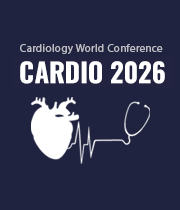Title : Acute inferior STEMI in a young male with factor V leiden mutation and testosterone-induced hypercoagulability: A case report
Abstract:
Acute ST-elevation myocardial infarction (STEMI) in young adults is uncommon and often driven by nontraditional risk factors, such as inherited thrombophilias and exogenous hormone use. This case report describes a 27-year-old Middle Eastern male who presented with acute inferior STEMI despite an absence of atherosclerosis. His medical history was notable for long-term testosterone therapy for hypogonadism and a newly discovered family history of heterozygous Factor V Leiden (FVL) mutation. Initial angiography revealed a large obstructive thrombus in the proximal right coronary artery (RCA) with TIMI-0 flow. Radial artery access was initially attempted but failed due to anatomical abnormality, necessitating femoral access. Manual thrombectomy restored TIMI-3 flow, and he was placed on continuous heparin infusion.
Despite appropriate anticoagulation, persistent RCA thrombus was noted on repeat angiography. The clinical course was complicated by post-testosterone withdrawal thrombocytosis (>850,000/µL), contributing to refractory thrombus formation. A third angiogram revealed continued thrombus burden and impaired coronary flow, prompting the placement of a drug-eluting stent, which successfully restored perfusion. Following the stent, heparin therapy was discontinued. Five hours after the discontinuation of heparin therapy, the patient developed an approximately 90% radial artery occlusion, which persisted for 2–3 weeks despite treatment.
Following stabilization, the patient was discharged on rivaroxaban (2.5 mg BID) in addition to dual antiplatelet therapy with aspirin and ticagrelor, along with high-intensity statin therapy for dyslipidemia management. His follow-up plan included evaluation for additional thrombophilic disorders and discussion of alternative hormone management strategies.
This case highlights the need for heightened clinical awareness of hypercoagulable states in young patients presenting with myocardial infarction, particularly those on exogenous testosterone therapy. It emphasizes the importance of early genetic screening, careful monitoring of thrombotic complications, and individualized management strategies to optimize outcomes. Moreover, this case underscores the potential risks associated with testosterone use in individuals with inherited thrombophilias and raises important considerations for the safety of long-term hormone therapy in high-risk populations.



